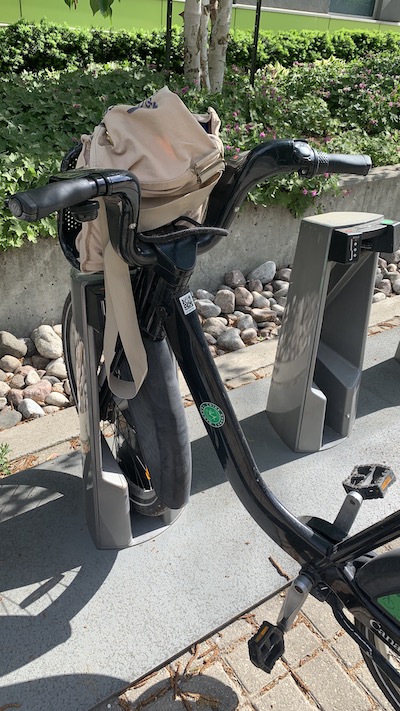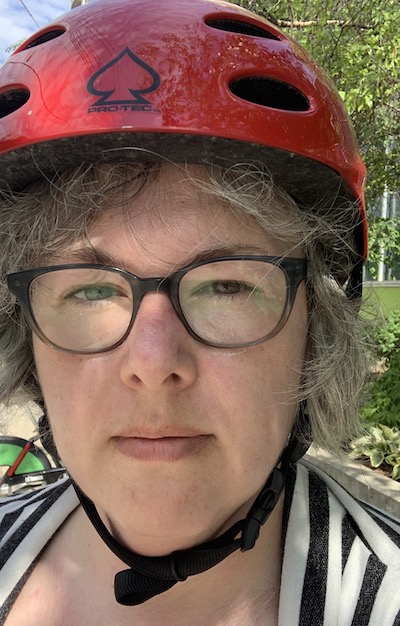The Paradox of Adventure
“Is this what you wanted? Really?” I asked myself as I heaved the heavy bike over a root, steadying myself as my boots slipped in the silty mud.
“You said you wanted more adventure, didn’t you?” I continued to berate myself. “Is this what you had in mind?”
It was not. I didn’t want to be hauling, lifting, and slipping. All I wanted was to be back on level ground and actually on the bike, wind in my hair.
I had booked myself a bike through the city’s bike share program and gone on a little adventure, biking south to the edge of downtown. The city bikes are solid and heavy, with a tubular steel basket for your briefcase or backpack and three gears, none of which go very fast. They are built for sturdy utility, not speed.

On the way down I rode along bike paths and quiet streets, through one of Toronto’s nicest neighbourhoods. On the way home, I decided to go through the ravine. My bike-and-hike mapping app said it was an easy ride, mostly paved and hard-packed paths, so I didn’t anticipate any problems.
Once I found my way into the ravine (a feat in itself — the ravine access points are obscure, presumably to force would-be explorers to prove their commitment) I happily pedaled along a hard-packed, groomed trail beside sunny lawns and a bubbling stream. The water level was low but swift between rock walls. People stood beside the water, posing for photographs and laughing.
The trail moved into bright, airy forest but remained wide and defined. But as I biked on it become narrower, until I found myself pedalling along a muddy trail created, not by city workers but by footsteps and bike tires.
I soon realized I was on the Wrong Side of the ravine.
At some point — a point which was apparently behind me — there’s a fork in the trail. If you go one way, you cross a bridge to the west side of Yellow Creek. The path there is groomed, graded, and sometimes even paved. If you miss the fork, and it’s easy to miss, you stay on the east side. There is no official path on the east side, but an organic trail, muddy and narrow and interrupted by exposed roots, fallen trees, and rivulets of runoff from the neighbouring streets.
Which is all very well if you are on a mountain bike, or on foot, but I had my giant, solid city bike.
Several hazards came to mind. What if the path peters out or becomes impassable and I have to turn back? I hate turning back. Annoying! What if I slip and break an ankle and someone has to come get me? Embarrassing and painful! What if I’m late returning the bike and I have to pay the overtime fee? Frustrating! What if a passerby realizes I made a mistake because no-one would deliberately choose to go on the wrong side of the ravine with a city bike? Mortifying!
But most of all, I asked myself, is this the adventure you wanted?

What is adventure?
I love adventure. I’ve been craving it lately — something new, something spicy.
But it seems when I’m finally get the adventure I crave, all I can think about is how it might get worse and when it will end.
Because I also love comfort. A belly full of food, a hot bath, a firm mattress with clean smooth sheets… these are a few of my favourite things.
It could be that adventure and comfort are a natural duality, each providing the contrast that offsets the other, like night and day. Aren’t they mutually exclusive?
But no, that’s not exactly true, because I can think of a counter-example, a situation when comfort makes adventure better: a good pair of hiking books. The pain of bad hiking boots would not make an adventure better, it would make it worse. But without any discomfort, a challenging hike wouldn’t be an adventure at all — would it?
If that’s true, it means pain is not a necessary part of adventure. Discomfort, yes; pain, no.
But isn’t the different between discomfort and pain a matter of degree? Probably. So maybe we need a new distinction, between good adventure and bad adventure. And that difference is also a matter of degree, and it has to do with whether discomfort (good adventure) becomes pain (bad adventure).
An adventure pushes you into the realm of things you don’t usually do out of habit or fear or just lack of opportunity. Whether you’re hiking with good boots or bad boots, you’re still challenging yourself. But the good boots mean the challenge is about strength and persistence and courage, not the ability to endure pain and suffering.
Another ingredient of adventure is risk: my mental tally of things that could wrong. In a way, risk is just the possibility of challenges yet to come, and again degree is important.
For me, I don’t want mortal danger in my adventures; I’m not about to do anything that is likely to kill me. The right risk for me is the danger of a wrong turn, of having to explain myself to someone who doesn’t share a language, of losing my luggage or my hotel room reservation. Of climbing more stairs than I thought I could or eating unfamiliar food or making a fool of myself. I’m a risk lightweight.
But risk, however modest, is necessary for adventure because if everything is strictly controlled and managed, there is also no risk of serendipity, of discovery, of an unexpected moment of transcendence, of realizing that you are capable of so much more than you thought. Without challenge pushing you, there is no possibility of growth.
Some things are just hard
But also, lots of things are challenging without being adventures. Doing taxes, working out, raking the yard, getting sick, cleaning up the kitchen after you drop a whole pot of chili… So challenge is necessary to adventure, but it’s not sufficient.
So there’s more to adventure than just challenge, and for me the other ingredient is novelty. I am hungry for new sensations, new ideas, new people and places.
What is it about adventure?
Adventure requires challenge, but calibrated challenge: discomfort, not pain; inconvenience, not mortal danger. And adventure requires novelty, of experiences and of what it takes you to get through them. If there is no challenge, it’s not an adventure (it’s just fun) and if there’s no novelty, it’s not an adventure, it’s just hard.
I crave adventure. And the minute I start having an adventure, I can’t wait for it to be over. I started thinking this through because I wanted to understand that paradox by understanding what it is about adventure that I value. This is what I learned.
• The things I value about adventure are challenge and novelty. • Challenge exists on a continuum from uncomfortable to painful to dangerous. • Adventures exist on a directly related continuum from good to bad.
I have “adventure” written down in my notebook as a value, but now I am going to cross it off and replace it with “novelty” and “challenge”. Adventures are simply a container for those two things.
Why is that important? Because I use my values as a compass to guide the choices I make, and a compass should be precise and accurate. Knowing exactly what I get out of adventures will make it easier for me to say yes to the right kind and no to the wrong kind.
Coda
A good story has a beginning, a middle and an end, and a couple of readers pointed out that I forgot to write the end. I did get out of the ravine, dear reader. I hauled that bike down a semi-paved slope, across the creek at a shallow rocky place, and back up a matching slope. That brought me to the official path, groomed and very comfortable.
Also unresolved is the paradox of adventure itself, and unresolved it will remain. Yes, adventures are awful. Yes, I want more adventures. Paradoxes make life interesting. What is more stimulating than two opposite things being true at the same time?
Practically, the perennial truth holds: Knowing is half the battle. Like exercise, adventures are much better when they are over, and like exercise, you can’t cheat. You have to do the thing, with the discomfort, to get the benefit.
So now I know, and next time I’m miserably in the thick of things I’ll remember that I signed up for this, and it will be worth it. Rather than wallow in the misery, I’ll notice how I’m rising to the challenge, and maybe even try to enjoy myself.